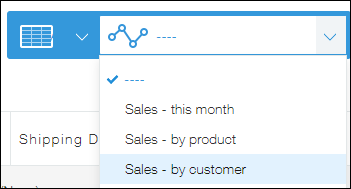Reflejar un resultado agregado en una aplicación diferente
Puedes exportar datos agregados a un archivo y luego reflejarlos en otra aplicación importándolos. Los pasos son los siguientes.
(1) Realizar agregación de datos
(2) Exportar los datos agregados a un archivo
(3) Activar la configuración Prohibir valores duplicados si es necesario
(4) Importar el archivo exportado a una aplicación diferente
El siguiente ejemplo muestra cómo calcular el monto de ventas por cliente en la aplicación "Gestión de ventas" y reflejar el resultado del cálculo en la aplicación "Base de datos de clientes".
Realizar agregación de datos
Primero, crea un gráfico de ventas por cliente en la aplicación “Gestión de Ventas”.
-
Abra la aplicación "Gestión de ventas".
-
Haga clic en el ícono de configuración de la aplicación (el ícono con forma de engranaje) en la parte superior derecha de la pantalla Vista.

-
En la pantalla de configuración de la aplicación, haga clic en la pestaña Gráficos.
-
Haga clic en el icono Crear gráfico (el icono con forma de signo más) a la derecha de la pantalla.
-
Especifique el tipo de gráfico, Función y otras configuraciones según sea necesario.
Para este ejemplo, utilizaremos la siguiente configuración.- Tipo de gráfico: Tabla
- Nivel 1: Nombre del cliente
- Función: Suma, Importe de ventas
-
Haga clic en Guardar en la parte inferior derecha de la pantalla.
-
Haga clic en Actualizar aplicación en la parte superior derecha de la pantalla.
-
En el cuadro de diálogo de confirmación, haga clic en Actualizar aplicación.
Exportar los datos agregados a un archivo
A continuación, exporte los datos agregados a un archivo.
-
En la pantalla Vista de la aplicación "Gestión de ventas", muestre los datos agregados que desea exportar.

-
Haga clic en el icono Opciones en la parte superior derecha de la pantalla, luego haga clic en Exportar a archivo CSV.
-
Configure los ajustes de exportación según sea necesario, luego haga clic en Exportar en la parte superior izquierda de la pantalla.
-
Haga clic en el nombre del archivo CSV exportado y descargue el archivo.
Habilitar la configuración "Prohibir valores duplicados" si es necesario
Para actualizar los registros existentes, debe especificar un campo en Clave de actualización al importar el archivo.
Si desea configurar un campo distinto del campo Número de registro (un campo Texto, Número, Fecha, Fecha y hora o Enlace) en Clave de actualización, deberá habilitar Prohibir valores duplicados en la configuración del campo.
En el siguiente ejemplo, el campo "Nombre del cliente" (un campo Texto) se utiliza como clave de actualización, por lo que es necesario habilitar la configuración Prohibir valores duplicados para el campo en la aplicación "Base de datos de clientes".
-
Abra la aplicación "Base de datos de clientes".
-
Haga clic en el ícono de configuración de la aplicación (el ícono con forma de engranaje) en la parte superior derecha de la pantalla Vista.

-
En la pantalla de configuración de la aplicación, haga clic en la pestaña Formulario.
-
Coloque el cursor sobre el ícono de Configuración de campo (el ícono con forma de engranaje) para el campo "Nombre del cliente", luego haga clic en Ajustes.
-
Seleccionar la casilla de verificación Prohibir valores duplicados y luego haga clic en Guardar.
-
Haga clic en Actualizar aplicación en la parte superior derecha de la pantalla.
-
En el cuadro de diálogo de confirmación, haga clic en Actualizar aplicación.
Importar el archivo exportado a una aplicación diferente
Por último, importe el archivo exportado desde la aplicación “Gestión de ventas” a la aplicación “Base de datos de clientes”.
-
Haga clic en el ícono Opciones en la parte superior derecha de la aplicación "Base de datos de clientes", luego haga clic en Importar desde arch..
-
En 1. Especificar un archivo, especifique un archivo de Excel o un archivo CSV para importar.
-
En el 2. Especifique un formato de datos, seleccione la casilla de verificación La La primera fila del archivo contiene encabezados de columna si su archivo tiene nombres de columna ingresados en la primera fila.
-
En la 3. Especifique cómo importar los datos de registro y gestionar los errores, seleccione Actualizar y añadir registros en Datos de registro.
En este ejemplo, especificaremos el campo "Nombre del cliente" en Clave de actualización. -
En el 4. Relacione sus datos, especifique qué columna de su archivo corresponde a cada campo de la aplicación.
En este ejemplo, especificaremos "Nombre del cliente" e "Importe de ventas" en Columna del archivo. -
Haz clic en Importar en la parte inferior derecha de la pantalla.
